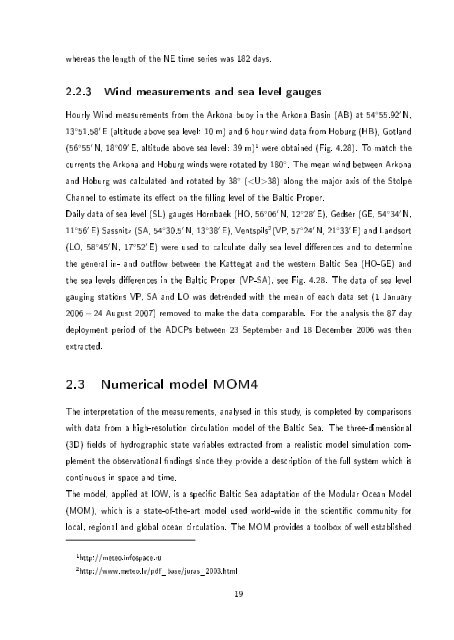Baltic Sea
Baltic Sea
Baltic Sea
You also want an ePaper? Increase the reach of your titles
YUMPU automatically turns print PDFs into web optimized ePapers that Google loves.
whereas the length of the NE time series was 182 days.<br />
2.2.3 Wind measurements and sea level gauges<br />
Hourly Wind measurements from the Arkona buoy in the Arkona Basin (AB) at 54 ◦ 55.92 ′ N,<br />
13 ◦ 51.58 ′ E (altitude above sea level: 10 m) and 6 hour wind data from Hoburg (HB), Gotland<br />
(56 ◦ 55 ′ N, 18 ◦ 09 ′ E, altitude above sea level: 39 m) 1 were obtained (Fig. 4.28). To match the<br />
currents the Arkona and Hoburg winds were rotated by 180 ◦ . The mean wind between Arkona<br />
and Hoburg was calculated and rotated by 38 ◦ (38) along the major axis of the Stolpe<br />
Channel to estimate its eect on the lling level of the <strong>Baltic</strong> Proper.<br />
Daily data of sea level (SL) gauges Hornbaek (HO, 56 ◦ 06 ′ N, 12 ◦ 28 ′ E), Gedser (GE, 54 ◦ 34 ′ N,<br />
11 ◦ 56 ′ E) Sassnitz (SA, 54 ◦ 30.5 ′ N, 13 ◦ 38 ′ E), Ventspils 2 (VP, 57 ◦ 24 ′ N, 21 ◦ 33 ′ E) and Landsort<br />
(LO, 58 ◦ 45 ′ N, 17 ◦ 52 ′ E) were used to calculate daily sea level dierences and to determine<br />
the general in- and outow between the Kattegat and the western <strong>Baltic</strong> <strong>Sea</strong> (HO-GE) and<br />
the sea levels dierences in the <strong>Baltic</strong> Proper (VP-SA), see Fig. 4.28. The data of sea level<br />
gauging stations VP, SA and LO was detrended with the mean of each data set (1 January<br />
2006 − 24 August 2007) removed to make the data comparable. For the analysis the 87 day<br />
deployment period of the ADCPs between 23 September and 18 December 2006 was then<br />
extracted.<br />
2.3 Numerical model MOM4<br />
The interpretation of the measurements, analysed in this study, is completed by comparisons<br />
with data from a high-resolution circulation model of the <strong>Baltic</strong> <strong>Sea</strong>. The three-dimensional<br />
(3D) elds of hydrographic state variables extracted from a realistic model simulation complement<br />
the observational ndings since they provide a description of the full system which is<br />
continuous in space and time.<br />
The model, applied at IOW, is a specic <strong>Baltic</strong> <strong>Sea</strong> adaptation of the Modular Ocean Model<br />
(MOM), which is a state-of-the-art model used world-wide in the scientic community for<br />
local, regional and global ocean circulation. The MOM provides a toolbox of well established<br />
1http://meteo.infospace.ru<br />
2http://www.meteo.lv/pdf_base/juras_2003.html<br />
19



